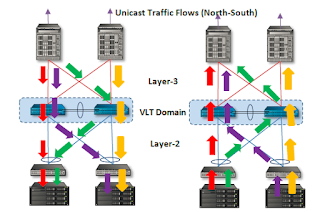DELL MXL VLT | Server administrator version

This blog will be taking server administrators through the VLT dilemma. The blog will not be discussing any networking concepts in detail as I'm not the right one to do so. :) ... But I can help you to understand the Dell MXL VLT concept. What is VLT ? VLT ( Virtual Link Trunking) is a logical domain which consists of multiple MXL switches. VLTi is the physical interconnect which connects the peer switches. In VLT, each peer switches will have its own management, data and control planes. All required protocols and configurations should be configured separately in each switch. The peer switches will exchange L2 related tables with each other. Uplinks from the switches can be bundled to an LACP. The ability to create LACP between the switches would eliminate the need of STP thereby increasing the link bandwidth. The only supported STP protocol is RSTP and is only used to avoid looping in case of incorrect cabling. How is it different to stacking ? In stacki